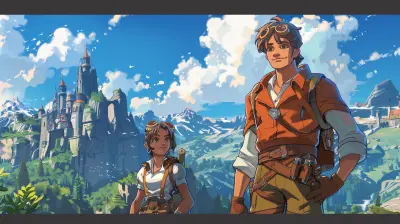Lead Developer Discusses the Thought Process Behind the New Patch
26 September 2025
Video game patches are like the lifelines of our favorite games—keeping them alive, balanced, and fresh in a world that's constantly evolving. But have you ever wondered what really goes on behind the scenes? What sparks the decisions that lead to that game-breaking bug finally getting squashed or that one overpowered weapon getting nerfed? Well, in a recent discussion, the lead developer of a fan-favorite title pulled back the curtain and gave us a glimpse into the thought process behind the upcoming patch.
In today’s article, we’ll dive deep into the nuances of game development and uncover exactly how game devs approach updates that keep us glued to our screens. 
The Big Picture: Why Patches Matter
Let’s be honest—patches are the lifeblood of online games. They’re the reason your favorite game doesn’t feel stale six months after launch. Whether it's fixing glitches, introducing new features, balancing gameplay, or adding lore content, every patch has a reason to exist.But here’s the thing: developing a patch isn’t just about pulling up a debug screen and hammering out code. It’s a process. And it’s this process that separates a smooth, game-changing patch from a rushed one that leaves the community frustrated.
The lead developer we’re spotlighting made it clear: patches aren’t just technical. They’re emotional. They’re about listening to the players, balancing priorities, and making tough calls. 
Listening to the Community: The First Step
Every game developer you’ve ever raged at for "ruining your favorite build" has probably spent hours combing through forums, Reddit threads, and social media posts.The lead dev broke it down: "The community is our compass." When players flood Twitter with complaints about an overpowered sniper rifle or a frustrating skill tree bug, that’s where the devs start taking notes.
Of course, not all feedback is created equal. Some players want more challenging mechanics. Others just want the game to be easier. So developers look for patterns—common threads that pop up across multiple platforms. Are weapons unbalanced? Are new players struggling to get into the game? Is a specific character too dominant in competitive play?
From there, they can build a roadmap of priorities. And trust me, that’s easier said than done. 
Balancing Priorities: It’s Like Spinning Plates
Gaming communities are a bit like pizza toppings—we all have our preferences. Some players prioritize competitive balance, while others care more about story content or quality-of-life improvements.The lead dev explained that every patch has to juggle multiple priorities. For instance, let’s say there’s a glitch where players fall through the map during a ranked match (ugh, the rage). That’s obviously high-priority because it literally breaks the game. But at the same time, there might be players demanding new skins or a rework of a character that feels outdated.
The challenge for devs? Deciding what’s "urgent" and what can wait. As the dev phrased it, "It’s like trying to fix a leaky roof while also redecorating the living room." 
The Art of Balance: Buffs, Nerfs, and Everything In Between
Can we talk about balancing for a second? Whether you play shooters, RPGs, or MOBAs, you’ve probably cursed the devs at some point for nerfing your go-to weapon or ability. But here’s the thing—balance changes aren’t just made to annoy you.The lead developer gave some insight into how they approach buffs and nerfs. It’s not as simple as just looking at data (although, yeah, stats matter). It’s also about keeping the game fun.
For example, let’s say a sword in a fantasy game is so overpowered that everyone’s using it. Sure, the data might show it has a 70% win rate, but the bigger issue is that it’s squashing creativity. Devs want players to feel like they have choices—not just one "meta" way to play.
At the same time, they don’t want to nerf something so hard that it becomes useless. It’s all about maintaining that delicate balance. "Nerfing is like seasoning," the dev said. "Too much salt, and it’s ruined. Not enough, and it’s bland."
Testing, Testing, and More Testing
So, once the team has a plan for the patch, it’s time to test. And no, we’re not talking about the kind of testing where you casually boot up the game and play for 10 minutes. We’re talking about grueling, hours-long stress tests that push the game to its limits.The dev explained that internal testing teams are the unsung heroes of game development. They’re the ones who find all the weird edge cases—like what happens if you hit five enemies at once with an explosion or teleport across the map while crouching.
But even with all that testing, not every bug gets caught. That’s why so many games have public test servers (PTS). It’s like a trial run where the community can jump in and help sniff out issues before the patch goes live. Sure, it’s bumpy, but it’s also necessary.
The Emotional Side of Patching: Handling Player Expectations
Patching isn’t just about coding and testing—it’s about managing expectations. The lead dev admitted that players don’t always respond well to changes. Let’s face it, gamers are passionate (and maybe a little dramatic), so even minor tweaks can set off a wave of backlash.To navigate this, transparency is key. The dev shared that their team tries to be as open as possible about why certain decisions were made. Patch notes need to go beyond just saying "Fixed an issue." Players want to know why something was changed and how it’ll affect the game moving forward.
By the way, if you’ve ever appreciated well-written patch notes, give your favorite devs some love—they probably agonized over every word to make sure they got it right.
What’s Coming in the New Patch?
While the lead dev didn’t spill all the details about the upcoming patch, they did leave us with a few tantalizing hints:- Major balance changes: Expect a handful of buffs and nerfs designed to shake up the current meta.
- Quality-of-life tweaks: These updates focus on making the game smoother, from UI improvements to faster load times.
- Bug fixes galore: A couple of long-standing issues are finally getting resolved. Hallelujah.
- Surprises: The dev teased an “unannounced feature” that’s sure to get the community buzzing. Could it be new content? A gameplay overhaul? Your guess is as good as mine.
Final Thoughts
Game development isn’t just about writing code—it’s about creating an experience. And patches are a massive part of that experience. From gathering community feedback to testing every nook and cranny, every update is a labor of love.The lead dev summed it up perfectly: "At the end of the day, we’re gamers too. We’re not just making a game. We’re making a world we want to play in."
So the next time you see patch notes drop, take a moment to appreciate the sheer effort and thought that went into it.
all images in this post were generated using AI tools
Category:
Updates And PatchesAuthor:

Lucy Ross
Discussion
rate this article
1 comments
Ashira Pope
Exciting insights! It's inspiring to see the passion and dedication behind this game’s evolution!
October 1, 2025 at 4:14 PM

Lucy Ross
Thank you! I'm glad you found it inspiring! Our team is committed to creating a game that resonates with our players.


